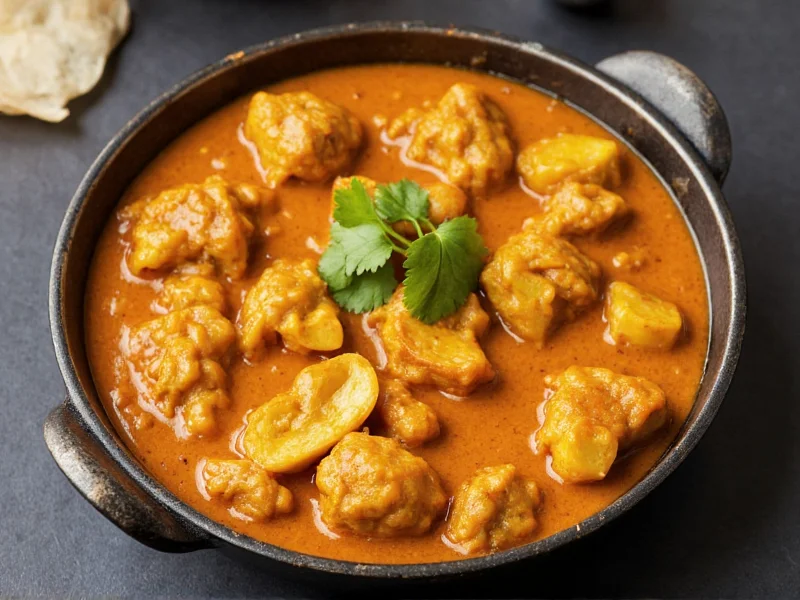Understanding what curry is made of requires recognizing two distinct interpretations: curry as a spice blend and curry as a category of dishes. This distinction explains why the answer isn't as straightforward as listing a single set of ingredients.
The Dual Nature of Curry
Many Western consumers mistakenly believe "curry" refers to a single spice or dish. In reality, the term represents two different concepts:
- Curry powder - A British colonial invention created to mimic South Asian spice blends
- Curry dishes - A wide range of saucy preparations found across South Asia, Southeast Asia, and beyond
Core Components of Curry Powder
Commercial curry powder typically contains these essential spices:
| Primary Spice | Percentage in Blend | Flavor Contribution |
|---|---|---|
| Turmeric | 25-30% | Earthiness, vibrant yellow color |
| Coriander | 20-25% | Citrusy, slightly sweet base note |
| Cumin | 15-20% | Earthy, warm undertones |
| Fenugreek | 10-15% | Slightly bitter, maple-like notes |
| Chili powder | 5-10% | Heat level variable by blend |
Additional common ingredients include mustard seeds, black pepper, cardamom, and cloves. The exact proportions vary significantly between brands and regional preferences. Authentic Indian cooking rarely uses pre-mixed curry powder, instead creating fresh blends for specific dishes.
What Makes Curry Dishes
When discussing curry as a dish rather than a spice blend, ingredients vary dramatically by region:
Indian Curry Foundations
Traditional Indian curries build flavor through:
- Tempering - Heating spices in oil to release flavors
- Onion-ginger-garlic base - The flavor foundation for most curries
- Liquid component - Tomatoes, yogurt, coconut milk, or broth
- Protein or vegetables - Chicken, lamb, fish, paneer, or seasonal vegetables
- Whole spices - Added during cooking for depth
Regional Variations
Curry preparations differ significantly across cultures:
- Thai curries rely on fresh curry pastes made from lemongrass, galangal, kaffir lime leaves, and shrimp paste
- Japanese curry features a roux-based sauce with apples and honey for sweetness
- Sri Lankan curries often include roasted curry powder and unique spice combinations
- Caribbean curries incorporate allspice and Scotch bonnet peppers
Common Misconceptions About Curry Ingredients
Several misunderstandings persist about what curry contains:
- Curry isn't a single spice - No traditional South Asian cuisine refers to a generic "curry spice"
- Not all curries are spicy - Heat level varies dramatically by region and dish
- Coconut milk isn't universal - Northern Indian curries typically use dairy instead
- "Curry" is largely a British term - South Asians refer to specific dishes like masala, jalfrezi, or korma
Creating Authentic Curry Flavors
For those interested in making curry from scratch rather than using pre-mixed powder, consider these professional tips:
- Dry roast whole spices before grinding to enhance flavor complexity
- Bloom spices in oil at the beginning of cooking to distribute flavors evenly
- Add acidic components like tomatoes or tamarind late in cooking to preserve brightness
- Balance the six tastes - sweet, sour, salty, bitter, pungent, and astringent
- Use fresh ingredients - Pre-ground spices lose potency within 6 months
Identifying Quality Curry Products
When purchasing curry powder or paste, look for these quality indicators:
- Minimal ingredients list without fillers or artificial colors
- Fragrant aroma when opened (stale spices lose potency)
- Deep, vibrant color (pale powder suggests old or diluted product)
- Transparent labeling of spice origins when possible
- Small batch production for freshness
Remember that the best curry experiences come from understanding regional differences rather than seeking a universal "curry" formula. Exploring specific dishes like butter chicken, green curry, or vindaloo provides more authentic culinary insight than searching for a single definition of curry ingredients.
What are the main spices in traditional curry powder?
Traditional curry powder primarily contains turmeric (for color), coriander, cumin, fenugreek, and chili peppers. Additional common ingredients include mustard seeds, black pepper, cardamom, and cloves. The exact proportions vary by region and brand, with turmeric typically making up 25-30% of the blend.
Is curry powder the same in all curry dishes?
No, curry powder isn't used in most traditional curry dishes. The term "curry" refers to diverse regional dishes that use unique spice combinations. Indian cuisine typically creates fresh spice blends for specific dishes rather than using pre-mixed curry powder. Thai curries use fresh curry pastes, while Japanese curry relies on roux-based sauces.
What gives curry its yellow color?
Turmeric is primarily responsible for the yellow color in most curry dishes and powders. This vibrant spice contains curcumin, which provides both the distinctive color and many of curry's purported health benefits. The intensity of yellow varies based on turmeric quantity and whether other colorants like saffron are included.
Are all curries spicy hot?
No, not all curries are spicy. Heat level varies significantly by region and dish. Many Indian curries like butter chicken or korma are mild, while others like vindaloo are very hot. Thai curries range from mild yellow curry to extremely hot jungle curry. The misconception that all curries are spicy comes from Western interpretations that often emphasize heat over complex flavor profiles.
What's the difference between curry powder and garam masala?
Curry powder is a British creation typically containing turmeric, giving it a yellow color, while garam masala is an authentic Indian spice blend without turmeric. Garam masala features warming spices like cardamom, cinnamon, and cloves, and is usually added at the end of cooking. Curry powder often includes chili peppers for heat, while traditional garam masala focuses on aromatic warmth without significant heat.











 浙公网安备
33010002000092号
浙公网安备
33010002000092号 浙B2-20120091-4
浙B2-20120091-4